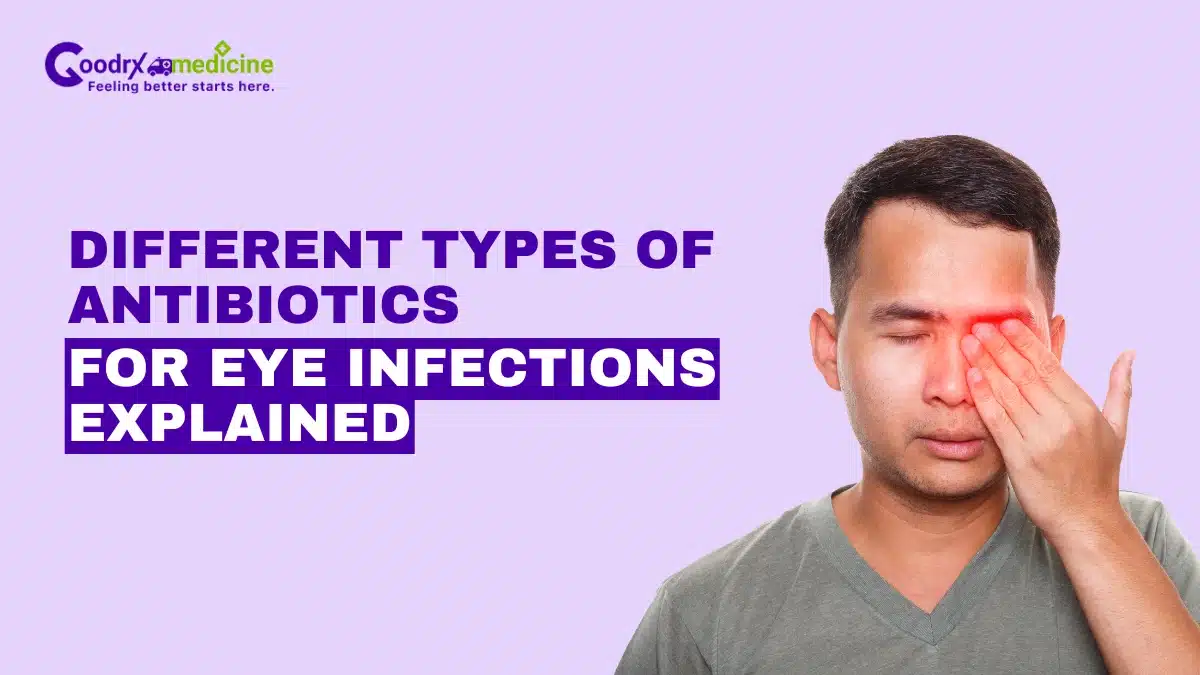Antibiotics for eye infections are medicines that treat bacterial problems affecting the eye’s surface or surrounding tissues. These infections can cause symptoms like redness, swelling, pain, discharge, and blurred vision. If left untreated, some bacterial eye infections can damage vision permanently.
Doctors choose the right antibiotic based on the infection’s cause, severity, location, and whether the medicine should be applied directly to the eye or administered by mouth. Unlike viral or allergic eye problems, bacterial infections usually respond well to antibiotics, but only when used correctly.
Using them unnecessarily can cause antibiotic resistance, side effects, or even secondary infections. This article will explain the types of antibiotics used for eye infections, how they are given, and key safety tips to remember so you can understand exactly how these treatments work and when they’re necessary.
Main types of antibiotics for eye infections
There are several classes into which antibiotics are divided, and not all of them are prescribed for eye infections. Here are the main categories of antibiotics used in eye care, and what they target:
- Aminoglycosides: This class includes options like Tobramycin and Gentamicin, which work well against Gram-negative bacteria and some Gram-positive types.
- Penicillins: They include antibiotics like Amoxicillin and Nafcillin that are effective against many Gram-positive bacteria and some Gram-negative types. They are sometimes used for severe or deep ocular infections and infections caused by Streptococcus, Neisseria, and Clostridium species.
- Fluoroquinolones: Some Fluoroquinolones, like Moxifloxacin, Ciprofloxacin, and Ofloxacin, are broad-spectrum and useful for corneal ulcers or resistant bacteria.
- Macrolides: Options like Erythromycin and Azithromycin are often prescribed for mild to moderate bacterial eye infections and are safe for children.
- Cephalosporins: They include options like Ceftriaxone and Ceftazidime. This class has a broad spectrum and is used for serious eye infections, including Endophthalmitis and Orbital Cellulitis.
- Polypeptides: These include options like Polymyxin B, which, when combined with Trimethoprim, provides broader coverage against different bacteria.
- Sulfonamides: Sulfacetamide sodium is less common today but can treat some instances of Conjunctivitis.
- Tetracyclines: Medicines like Doxycycline are used in some eyelid disorders, such as Blepharitis or Chlamydial infection, but they are not usually first-line for Acute Conjunctivitis.
Save up to 90% on your medicine bills

Milflox 0.5% 5 ml

Oflox 5 ml

Mosi Eye Drop

Xinep 5 ml
Forms of antibiotic treatment
Antibiotics for eye infections can be given in different ways depending on the severity or location of the infection.
- Eye drops and ointments: Topical options deliver medicine directly to the eye and are used for surface infections like Conjunctivitis and Keratitis.
- Oral antibiotics: Tablets are used for infections that spread to nearby tissues or for certain systemic infections affecting the eye, such as Chlamydial Conjunctivitis.
- Fortified antibiotics: These are high-strength solutions made in specialized pharmacies for severe corneal ulcers or resistant bacteria.
- Injections or intravitreal antibiotics: In severe or sight-threatening infections like Endophthalmitis, doctors may inject antibiotics such as Vancomycin or Ceftazidime directly into the eye. This delivers high concentrations of medicine to the affected tissues and helps control aggressive infections quickly.
When are antibiotics needed for eye infections?
Antibiotics are only useful when bacteria cause an eye infection. Sometimes, a combination of two or more antibiotics is used for more effective treatment. However, viral infections, allergic reactions, or fungal eye problems do not improve with antibiotics and may worsen if these medicines are misused.
A proper diagnosis from a qualified eye specialist is vital before starting treatment, as symptoms alone cannot confirm if bacteria are the cause.
Safety tips when using antibiotics for the eyes
Always follow your doctor’s instructions when using prescription eye drops. Here are the general tips:
- Wash your hands before and after applying medicine.
- Avoid touching the dropper tip to your eye or lashes.
- Never share your eye medicines.
- Complete the full course even if symptoms improve early. Misuse can cause resistance, treatment failure, or unnecessary side effects.
- In case of side effects, contact your doctor immediately.
Conclusion
Antibiotics for eye infections are essential in treating bacterial eye conditions and preventing complications that could threaten vision. They are available in different types: Aminoglycosides, Macrolides, Fluoroquinolones, Polypeptides, and Sulfonamides. They can be given as drops, ointments, oral tablets, or fortified solutions for severe cases.
The correct choice depends on the specific bacteria, the severity of the infection, and whether other parts of the eye are involved. While these medicines are highly effective, they are unsuitable for every eye problem and should never be used without professional diagnosis.
Using antibiotics properly means completing the whole course, applying them correctly, and avoiding unnecessary use. Following medical advice and practicing good eye hygiene can also effectively treat bacterial infections while reducing the risk of resistance or long-term damage.

Frequently Asked Questions
Can I wear contact lenses while using antibiotic eye drops?
No, wearing lenses can reduce the amount of medicine that comes into contact with the eye and increase the risk of bacterial growth. Remove them until your doctor confirms complete healing. This helps prevent reinfection and ensures the antibiotic works effectively throughout treatment.
Do antibiotic eye drops work for styes?
Yes, sometimes. If a stye is caused by bacterial infection, your doctor may prescribe drops or ointment. Many styes resolve with warm compresses alone. Professional diagnosis ensures the correct treatment and prevents unnecessary antibiotic use, which can contribute to resistance and other eye issues.
Are antibiotic ointments better than drops?
No, not always. Ointments last longer on the eye surface, which is helpful for night use, while drops suit daytime application. In some cases, both are used together to improve treatment results. Your doctor will decide which option or combination works best for your condition.
Is it safe to use expired antibiotic eye drops?
No, expired drops may lose potency and become contaminated. Using them can worsen the infection or introduce harmful bacteria. Always check the expiry date and discard unused medicine as instructed by your ophthalmologist or pharmacist to protect your eye health and vision.
When referencing outside resources, GoodrxMedicine always provides full citations. To learn more about the measures we use to maintain the quality of our content, please review our Content Information Policy.











